Jat Belt
| Author of this article is Laxman Burdak लक्ष्मण बुरड़क |
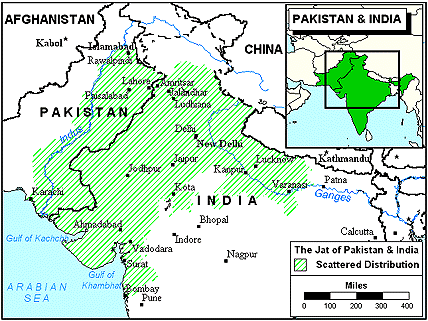
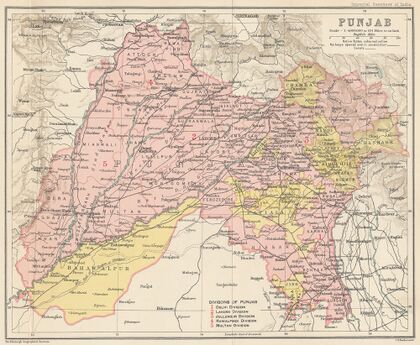
Jat Belt is the area of continuous Distribution of Jat population. This comes in discussions frequently during elections in India. The support of these areas is very crucial for the political parties in winning elections. The States in India with significant Jat population are: Rajasthan, Haryana, Delhi, Punjab, Uttar Pradesh. The other States with lesser number of population of the Jats are: Jammu and Kashmir, Himachal Pradesh, Madhya Pradesh, Gujarat, Maharashtra.
There is an estimate of about 33 million population of Jats. Main concentration of the Jats is in North Western India. Other than India they are found in Pakistan, Balochistan, NWFP etc.
Distribution of Jat population
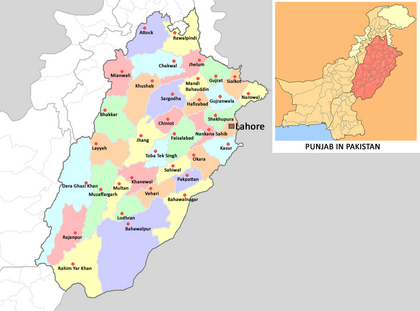
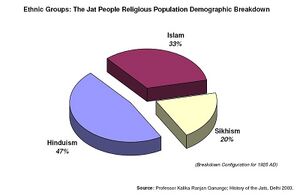
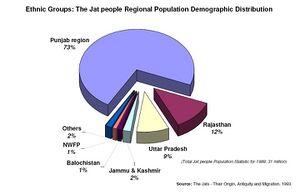
Hukum Singh Panwar (Pauria) [1] writes that adequate statistics are available in the Census Report of India, 1931, which is the last and the most comprehensive source of information on the Jats, who were estimated to be approximately one crore in number at that time[2] . They are believed to be distributed in about a thousand cans or gotras, while their clans virtually exceed three thousand[3]. Nearly six million Jats lived in the pre-partitioned Panjab (which included Haryana, Himachal Pradesh and the present Panjabs of the India and Pakistan), nearly one million in Rajasthan about 8,00,000 in the Uttar Pradesh while large groups of them resided in Jammu and Kashmir the Western Frontier Province, Baluchistan and Sindh[4]. Their number in Kirman and Iraq was about 20,000, in Makran and Afghanistan about 50,000[5]. They are also found in the Madhya Pradesh, Maharashtra and Gujrat-Kutch, but not in very large.
The census in 1931 in India recorded population on the basis of ethnicity. In 1925, according to Professor Qanungo[6] the population of Jatts was around nine million in South Asia and was made up of followers of three major religions as shown below.
| Religion | Jat Population % |
|---|---|
| Hinduism | 47% |
| Sikhism | 20% |
| Islam | 33% |
Professor B.S. Dhillon, states by taking population statistical analysis into consideration the Jatt population growth of both India and Pakistan since 1925, Professor Quanungo's figure of nine million could be translated into a minimum population statistic (1988) of 30 million.[7]
According to earlier censuses, the Jatt or Jat people accounted for approximately 25% of the entire Sindhi-Punjabi speaking area, making it the one of "largest single socially distinctive group" in the region.[8]
Hukum Singh Pawar (Pauria) states, adequate statistics about Jat people population are available in the Census Report of India of 1931, which is the last and the most comprehensive source of information on the Jat people, who were estimated to be approximately ten million in number at that time.[9] From 1931 to 1988 the estimated increase in the Jat people population of the Indian subcontinent including Pakistan respectively is 3.5% Hindu, 3.5% Sikh and 4.0% Muslim.[10] Dr Sukhbir Singh estimates that the population of Hindu Jatts, numbered at 2,210,945 in the 1931 census, rose to about 7,738,308 by 1988, whereas Muslim Jatts, numbered at 3,287,875 in 1931, would have risen to about 13,151,500 in 1988. The total population of Jatts was given as 8,406,375 in 1931, and estimated to have been about 31,066,253 in 1988.
The region-wise break-up of the total Jat people population, (including the Hindu Jats, Sikh Jats and Muslim Jat Gotras), is given in the following table. The Jat people, approximately 73%, are located mainly in the Punjab region:[11]
| Name of region | Jat Population 1931 | Jat Population 1988 | Approx Percentage |
|---|---|---|---|
| Punjab region | 6,068,302 | 22,709,755 | 73 % |
| Rajasthan | 1,043,153 | 3,651,036 | 12 % |
| Uttar Pradesh | 810,114 | 2,845,244 | 9.2 % |
| Jammu & Kashmir | 148,993 | 581,477 | 2 % |
| Balochistan | 93,726 | 369,365 | 1.2 % |
| NWFP | 76,327 | 302,700 | 1 % |
| Bombay Presidency | 54,362 | 216,139 | 0.7 % |
| Delhi | 53,271 | 187,072 | 0.6 % |
| CP & Brar | 28,135 | 98,473 | 0.3 % |
| Ajmer-Marwar | 29,992 | 104,972 | 0.3 % |
| Total | 8,406,375 | 31,066,253 | 100 % |
According to Hawa Singh Sangwan[12] the state-wise estimated Jat population is as under:
| S.No. | Name of State | Jat Population (Lakh) |
|---|---|---|
| 1. | Rajasthan | 100.00 |
| 2. | Punjab | 72.00 |
| 3. | Uttar Pradesh | 68.00 |
| 4. | Haryana | 64.00 |
| 5. | Delhi | 12.00 |
| 6. | Madhya Pradesh | 7.50 |
| 7. | Gujarat | 6.50 |
| 8. | Jammu and Kashmir | 5.50 |
| 9. | Uttaranchal | 2.30 |
| 10. | Himachal Pradesh | 1.30 |
| 11. | Bihar | 0.80 |
| 11. | Andhra Pradesh | 0.40 |
| 11. | Maharashtra | 0.30 |
| Total | 340.60 |
Distribution of Jat population in India
Ram Sarup Joon[13] writes that ....In the present era, people called Jats live in Northern India all around Delhi. The entire land in this area is owned by Jats. A minority of tradesmen and the so-called low or scheduled castes who live along with the Jats are landless. Brahmins possess has been obtained, at sortie time or the other, in charity and that owned by businessmen has been mortgaged by some Jats to clear their debts. It is difficult to find, anywhere in the world, a more homogeneous and closely-knit settlement than that of the Jats. Jat gotras are found mixed up amongst other communities in India like Rajput, Gujar and Ahirs but there is no adulteration amongst the Jats.
History of the Jats, End of Page-3
These Jats, however, are only a small representative group, of a once great and vastly populated race, who have retained their original name. The only other members of this race who are partially retaining the title of Jat are Jat Sikhs or Jut Sikhs, as they are called in Punjab. Some of these have even put forward the views that they are called as such not because they are originally Jats but because Jut means an agriculturist. Unless Jats regain their past glory, so that it becomes a matter of pride to be called a Jat, these Jat Sikhs may also, with the passage of time, stop calling themselves Jats, as has already been done by other communities comprising a major part of this race.
Jat is in fact only another name of Chandravanshi branch of Aryans which, at one time, extended in the entire area from Northern India to Central Asia and Central Europe. At different times, and in the ancient histories of various countries they have been known by one of the derivatives of word Jat like Yayat, Yat, Yet, Yeti, Yates, Yuchi Jat, Jati, Jutes, Juton, Gat, Gatae, Gatak, Goth etc or by the name of their major sub castes like Shavi, Takshak, Madrak etc.
The word Jat may not be, but these names would be familiar to the student of modern history. In India most of the population of North Western part: of the country, including the area astride River Sindh in West, the Gangetic planes in the East and down to Prayag, Bundel Khand in the South is of Jat origin. This area contains Punjab, part of Himachal Pradesh, Haryana, Uttar Pradesh, Rajasthan, Brij and Mewat. Jats have thus lived, from times immemorial, on the most fertile part of India. They did not find it necessary to spread in to the less fertile hilly tracts to the North, the waste lands of Central India or the deserts in Southern and
History of the Jats, End of Page-4
Western parts of Rajasthan. The density of the population of Jats, therefore, becomes thinner as one goes further East or South from Delhi. The reason for this homogeneous settlement on the most productive part of India is that 95 percent Jats are of the Yayati Vansh, which inhabited North Western India from the earliest times and have never been dislodged from it inspite of loss of power.
States with significant Jat density
Rajasthan
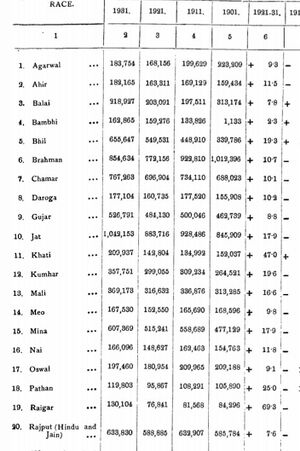
Jat population 1931 :
Thakur Deshraj has given an analysis of Jat population in Rajasthan as on 1931. Rajasthan was called Rajputana prior to independence. As per 1931 census the population of Jats in Rajasthan was as under:
Rajputana…………….1042152
Ajmer-Merwara………….30000
Bisnoi Jats………………69873
Total Jat population…. 1142025
The population of jats in then princely states where they were in sizable proportion was as under:
Bharatpur state…………72378
Bikaner state………….215947
Jaipur state……………313609
Marwar sate…………..283933
Bisnoi jats mainly inhabited the areas of Bikaner, Jaipur, Bharatpur, Marwar, Kishangarh and Mewar and their combined population was 69873.
The Jats in Bikaner, Jaipur and Jodhpur States were always a formidable factor. The Jat community was the most numerous and largest single community in the Princely States of Bikaner, Jaipur and Jodhpur.
A glance at the ‘Census Report of Marwar (Jodhpur State) for 1941’ [14], would make one aware of the size of the Jat community in the State. The total population of the State was 25,55,904 out of which 3,54,342 or approximately 14% were Jats. In the Jat belt extending from Malani paragana (present Barmer District bordering Sindh province), Jodhpur paragana (Jodhpur district) Merta, Nagaur, Didwana and Parabatsar paraganas (present Nagaur district) the Jats formed nearly 30% of the total population, not an insignificant proportion by any standard. Their capacity to create trouble in the State can, therefore, be easily visualized.
Highest Jat density areas in Rajasthan:
Thakur Deshraj has mentioned that the maximum density of Jats was in following tehsils in each princely state as under:
- Bikaner state – All tehsils
- Kishangarh state – Arai, Kishangarh, Rupnagar and Sarwar
Haryana
Haryana, Himachal Pradesh, Delhi, Punjab State of India and Punjab province of Pakistan were included in the Punjab region in 1931. Hence its Jat population in not known separately as on 1931.
Delhi
Haryana, Himachal Pradesh, Delhi, Punjab State of India and Punjab province of Pakistan were included in the Punjab region in 1931. Hence its Jat population in not known separately as on 1931.
Punjab
Haryana, Himachal Pradesh, Delhi, Punjab State of India and Punjab province of Pakistan were included in the Punjab region in 1931. Hence its Jat population in not known separately as on 1931.
Uttar Pradesh
The exact Jat population in Uttar Pradesh at present is not available as there is no caste wise census after 1931 in India. We can take 1931 Jat population as an indication of the proportion of it to the other castes. It can also be extrapolated on the ration of 2001 census and 1931 census, which can give approximate Jat population.
The total population of India in 1931 was 27.09 crore and in 2001 was 102.7 crore. Thus there is an increase of 3.681 times. On this basis the present Jat population in Uttar Pradesh must be 3.681 times 759830 = 2796900. Thus we can say population of Hindu Jats in Uttar Pradesh is 2796900.
Thakur Deshraj has given an analysis of Jat population in Uttar Pradesh as on 1931. Uttar Pradesh was called United Province prior to independence. As per 1931 census the population of Jats in Uttar Pradesh was as under:
Thus the 96.34 % population of Hindu Jats was in above 11 districts. The rest 24 districts like Dehradun, Farrukhabad, Itawa, Kanpur, Fatehpur, Allahabad, Varanasi, Mirjapur, Gazipur, Balia, Gorakhpur, Basti, Azamgarh, Mainpuri, Etah, Shahjahanpur,Pilibhit, Jhansi, Jalon, Hamirpur, Banda, Nainital, Almoda, Garhwal had a combines Hindu Jat population of 27847 (3.66 %).
In addition to this there are about 2.63 % Muslim Jats.
States with lesser population of Jats
Jammu & Kashmir
Himachal Pradesh
Haryana, Himachal Pradesh, Delhi, Punjab State of India and Punjab province of Pakistan were included in the Punjab region in 1931. Hence its Jat population in not known separately as on 1931.
According to some estimates ate present there are about 95,000 Jats in Himachal Pradesh, they are mainly Hindu Jats. They are about 1%(approx) of the total population of the state.
Uttarakhand
Madhya Pradesh
The population of Jats in Madhya Pradesh at present is not so significant to affect its policies but it has a sizable population in certain areas. The present Jats found in Madhya Pradesh trace their ancestors to have come from out side.
Jats migrated from Rajasthan: The Narmada River attracted them and they settled in Narsinghpur, Hoshangabad, Harda, Dewas, Indore and Dhar districts situated on the banks of Narmada.
Jats migrated from Uttar Pradesh, Haryana, Punjab:They settled in Bhind, Bhopal, Morena, Hoshangabad, Sagar, and Narsinghpur.
District wise distribution : Jats are found in districts:- Bhopal, Dewas, Dhar, Harda, Hoshangabad, Indore, Jabalpur, Khargone, Narsinghpur, Raisen, Rajgarh, Ratlam, Sehore, Shajapur, Tikamgarh, Ujjain, Vidisha.
Gujarat
Gujarat state has a sizable Hindu Jat population. The Jats came from a place in Iran called Half (to be known latter as Jat) and they were herders by occupation. Around five hundred years ago they came to Kutch and Sind in search of new grazing pastures and settled there. Those who joined agriculture called themselves Garasia Jats and those who continued their ancestral occupation were known as Dhanetah Jats, and those who chose to study the Koran became Fakirani Jats. [15] Kachchha-desa in Gujarat is also known Jartra–desa, the modern Kutch.[16]
The Jats of Kutch are a cattle breeding nomadic Muslim community. They are one of a number of communities of Maldhari pastoral nomads found in the Banni Grasslands Reserve region of Kutch.[17]
The Jat, or Jath in Kutch claim descent from Hindu Jats of the Indus delta region of Sindh, in Pakistan, where a good members of the tribe still reside. Those who remain in Sindh are referred to as the Sindhi Jats. From there, they moved into the Bani region in search of pastorage. With the partition of India, the Jats of Kutch have lost all contact with their kinsmen in Sindh. They appear to be distinct from the Jat community of North India and Pakistan.[18]
The Gujarati Muslim Jats are a Maldhari cattle hearding group, and are mainly distributed in Kutch and Saurashtra region. They have three territorial divisions, the 1. Halai Jat (found in Jamnagar and Porbandar), 2. Verai Jat (Banaskantha District), and 3. Kutchi Jat (found in Kutch District).
The Kutchi are further subdivided into the Dhanetah, Girasia and Fakirani, the latter consider themselves superior to the other two, and are strictly endogenous. They are further divided into clans like the Badajang, Podani, Aamar, Vangayi, while the Girasia are divided into the Mudrag, Bhallad and Hallayi. All these clans, except the Fakirani, enjoy equal status. The Saurashtra Jat, known as Malaks, maintain a system of Gotra exogamy.[19]
In addition to cattle rearing, the community are also involved in the breeding of camels, especially the Fakirani. A good many of the Saurashtra community are small scale peasant farmers. A few are landless, and work in as agricultural labourers. The Kutch Jat are also known for their embroidery work.
The Jats in Gujarat have come from Uttar Pradesh, Haryana, Rajasthan, Punjab, Himachal Pradesh and Madhya Pradesh. Patels and Chaudharys of Gujarat consider themselves to be Jats of Gujarat. They are settled mainly in Mehsana district and surrounding areas.
The Jats of Gujarat have many similarities with those of Haryana, Punjab, and Rajasthan. Signifant Jat population is in Banaskantha district, Ahmedabad. They are settled mainly in Mehsana district and surrounding areas. A few villages in Gujarat were jats live are Sherpura, Laxmipura, Yavarpura etc.
Maharashtra
Maharashtra is the state which is not normally regarded as having any Jat population. It is not true. The Jats had gone to some parts of Maharastra about 4 – 5 generations back. They are settled in the interior areas and doing cultivation. They came from states like Rajasthan, Punjab, Haryana etc. Jats are dwelling in Nasik, Jalgaon, Dhuliya, Aurangabad, Amravati districts. The Jat villages in these areas are called ‘Bavisi’. The villages in Jat ‘Bavisi’ are:
Nasik – Tokada, Jalkoo, Rajmana, Palarde, Hatane, Saytarpara, Jatpara (Nimbayatpada), Bhutpara, Dapaura, Chinchagyaha, Nardana, Palasdara, Lakhane
Jalgaon – Pinjarpara (Ramnagar), Rajoon, Manur, Talonda
Dhuliya – Kulthe
Aurangabad – Pardi, Anjangaon, Jalna, Lodhebari, Bamnod
Tokra (tehsil – Malegaon) in Nasik district is the main village of Jat Bavisi. This village is famous for cooperative societies in dairy. National leaders like Dara Singh, Dharmendra, Ram Niwas Mirdha etc have visited Tokra village.
Jats live in other districts of Maharashtra also. There is one taluka named Jat in Sangli district situated in south Maharashtra. The villages where Jats live are Londha (लोंढा) in tehsil Chalisgaon (Jalgaon), Amrawti (Pardi Via Badnera), Bhusawal tehsil Bhusawal (Jalgaon), Chandrapur (Chandrapur), Vardha, Hinganghat, Anjangaon, Ripur, Kasarkheda, Akola, Khamgaon, Jatol.
Karnataka
See details at Karnataka
Tamilnadu
See details at Tamilnadu
Andhra Pradesh and Telangana
Most Jats had historically settled around Golkunda area in 17th century. This area were these jats reside is now in newly formed state of Telangana which was carved out of Andgra Pradesh. See details at Andhra Pradesh.
Distribution of Jat population in Pakistan
Punjab region
| Name of Region | District | Tahsils in district | Population of Principal Muslim Jat clans in (1911) |
|---|---|---|---|
| Punjab region | 1.Sialkot | Daska, Pasrur, Sambrial, Sialkot | • Aulakh (614), Awan (714),Bains (626), Bajwa (13,727),Basra (3,583), Cheema (7,446), Deo (855), Dhariwal (524), Dhillon (2,758), Dhindsa (265), [Ghumman]] (7,579), Gill (3,468), Heer (73), Hanjra (1,744), Kahlon (6,285), Kang (173),Lidhar (614), Maan (169), Nagra (299), Pannun (357), Sahi (1,786), Sarai (1,041), Sidhu (404), Sandhu (5,054), Virk (1,670) and, Waraich (5,917).
|
| 2.Gujranwala | Gujranwala, Kamoke, Nowshera Virkan, Wazirabad | • Aulakh (357), Bajwa (2,483), Bhangu (372), Buttar (842), Chahal (609), Chatha (2,804), Chhina (3,252), Cheema (21,735), Deo (108), Dhariwal (744), Dhillon (769), Dhotar (357), Ghumman (1,429), Gill (2,635), Goraya (3,591),Haral (643), Hanjra (4,334),
Kahlon (261), Kharal (12,077), Khokhar (7,893), Lodike (2,675), Maan (463), Mangat (549), Randhawa (577),Sahi (1,050), Sarai (296), Sidhu (196), Sandhu (3,192),Sipra (658),Samra (406), Tarar (4,841), Virk (7,644) and,Waraich (9,510). | |
| 3.Lahore | • Aulakh (357), Awan (3,433), Bhatti (2,042), Bajwa (492), Bhullar (1,373), Buttar (198), Bath (340), Chauhan (393), Cheema (603), Chhina (742), Chander (1,221), Chahal (561), Deo (111), Dhillon (1,706), Dhariwal (752), Gill (2,381), Goraya (480),Ghumman (403), Gondal (1,080), Heer (376), Hanjra (836), Johiya (649), Khera (107), Kharal (2,064), Khokhar (2,708), Maan (637), Malhi (154), Pannun (7), Randhawa (162), Sidhu (1,022), Sandhu (9,965), Sarai (351), Sekhon (155), Sansi (522), Sial (1,373), Samra(45), Tarar (170), Uppal (87), Virk (1,375) and Waraich (357) | ||
| 4.Sahiwal | Sahiwal, Chichawatni | • Arar (1,800), Bhadro (638), Bhatti (1,978), Chadhar (2,283), Chauhan (517), Dhakku (673), Dhudhi (582), Hans (964), Jakhar (676), Johiya (979), Kalsan (576), Khagga, Khokhar (4,137), Kharal (735), Khichi (1,307), Mahar (1,225), Malil (1,633), Nonari (2,448), Sahu (1,178) and Sial (3,709) | |
| 5.Amritsar | • Aulakh (674), Bajwa (377), Bal (51), Bhangu (37), Bhullar (61), Chahal (91), Chadhar (166), Chhina (739), Cheema (137), Deo (237), Dhariwal (348), Dhillon (2,298),
Ghumman (477), Gill (4,346), Goraya (412), Heer (74), Hanjra (142),Hundal (230), Kahlon (390), Kang (97), Mahil (38), Maan (95), Pannun (91), Randhawa (2,661), Sarai (171), Sidhu (879), Sandhu (2,054), Sohal (218), Samra (53), Virk (325) and Waraich (492). | ||
| 6.Gurdaspur | • Atwal (227), Aulakh (99), Bajwa (844), Bains (853), Baal (117), Basra (458), Bhangu (106), Bhullar (192), Buttar (605), Bupa Rai (9), Chahal (48), Chattar (880),
Chhina (395), Chuna (415), Dhariwal (519), Dhillon (245), Gadri (555), Ghumman (851), Gill (1,198), Goraya (1,414), Hanjra (181), Jandi (538), Johal (55), Kahlon (1,729), Kallu (821), Khera (239), Malhi (51), Mami (166), Maan (354), Nat (755), Padda (151),Pannun (107), Randhawa ( 2,283), Rayar (578), Sarai (580), Sidhu (1,155),Sandhu (783), Sohal (197), Samra (184), Thathaal (473), Virk (1,017), Wahla (1,512), Waraich (2,512) | ||
| 7.Rawalpindi | Gujar Khan, Kahuta, Kallar Syedan, Kotli Sattian, Murree, Pothohar, Rawalpindi, Taxila | • Aura (610),Bangial (1,204), Baghial (96), Bains (1,332), Boria (46), Chhina (692), Dhamial (1,502), Dhamtal (520) ,Gondal (816), Hindan (541), Kalial (129),
Kanial (149), Khatrils (2,004), Mogial (69), Mial (25), Sudhan (175), Sial (420) and Thathaal (53). | |
| 8. Jhelum | Jhelum, Sohawa, Pind Dadan Khan and Dina | • Chadhar (601), Dhamial (4,370), Dhudhi (526), Gangal (1,049), Ghogha (710), Gondal (6,549), Gujjral (788), Hariar (579), Haral (500), Jandral (618), Jangal (572), Jhammat (1,471), Jatal (710), Kalial (3,039), Kanial (2,603), Khanda (734),Khangar (1,146), Khatarmal (1,184), Khokhar (603), Khoti (646), Manhas (457), Matial (1,147), Mekan (1,229), Mogial (1,830), Phaphra (663), Serwal (572), Sial (1,125), Tama (617), Tarar (745), Thathaal (1,230) and Raya (1,790). | |
| 9.Gujrat | Gujrat, Kharian, Sarai Alamgir | • Awan (1,780), Bagril (586), Bains or Wains (596),Bangial (1,679),Chadhar (976), Cheema (2,572), Chauhan 726, Dhillon (692), Dhotar (1,355), Ghumman ( 846), Gondal (23,355), Heer (1,451), Hanjra (3,736), Kang (1,032), Langrial (3,736), Mangat (1,075), Sahi (3,974), Sarai (631), Sipra (1,084), Tarar 14,365, Sandhu 3,442, Sial (1,511), Total (4,192), Thathaal (1,930), Virk (1,030), Waraich (41,557), Wadhan 662 | |
| 10.Sargodha | Bhalwal, Kot Momin, Sahiwal, Sargodha, Shahpur, Sillanwali | • Awan (1,219), Baghiar (807), Bajwa (1,686), Bhatti (4,212), Bhutta (753), Burana (935), Bains (712), Chadhar (4,001), Chhina (1,299), Cheema (2,708), Dhako (799), Dhudhi (1,405), Dhal (691), Ghumman (1,065), Gondal (28,623), Goraya 652), Haral (2,110), Hatiar (739), Heer (553), Hanjra (790), Jarola (550), Johiya (2,884), Jhawari (1,092), Jora (718), Kalera (679), Kaliar (855), Kharal (715), Khichi (633), Khokhar (5,228),Khat (1,005), Lak (1,779), Lali (684), Langah (638), Marath (548), Mekan (5,435), Naswana (505), Noons (708),Panjutha (596), Parhar (1,880), Rehan (1,880), Ranjha (7,536), Sagoo (715), Sandrana (577), Sandhu (504), Sipra (1,763), Sohal (810), Sujal (2,594), Talokar (966),
Tarar (1,716),Tatri (1,122), Tulla (1,311), Ves (1,158), Virk (626), Waraich (3,483). | |
| 11.Faisalabad | Faisalabad, Faisalabad Saddar, Chak Jhumra, Samundri, Jaranwala, Tandlianwala | • Ahir (580), Atwal (1,849), Aulakh (876), Awan (2,085), Bains or Waince (2,635),Bajwa (3,868), Bar (1,084), Bandech (725), Bhatti (9,190), Chadhar (3,428),
Chahal (444), Chhaj (510), Changar (843), Chatha (967), Cheema (629), Chhina (202), Chauhan (629), Dhillon (1,147), Dhariwal (596), Deo (610), Ghuman (1,022), Gill (3,865), Gondal (997),Goraya (2,158), Hundal (495), Haral (1,312), Hanjra (805), Janjua (509), Jauson (531), Johal (56), Johiya (1,371), Kahlon (3,037), Kaliar (312), Kamoka (943), Kalasan (581), Kharal (4,985), Khera (326), Khichi (2,219), Khinge (506), Khokhar (3,371), Lak (679), Lona (1,051), Lurka (2,288), Maan (437), Nonari (858), Pansota (1,941), Rajoke (981), Randhawa (2,335), Sahi (805), Sial (5,464), Sidhu (224), Sandhu (3,659), Sipra (1,943), Tarar (514), Vahniwal (782), Virk (1,005),Wahla (1,215), Waraich (3,443),Waseer (1,661), Wasli (67), Wattu (1,695), | |
| 12.Mianwali | Isakhel,Mianwali, Piplan | • Ahir (521), Arar (678), Asar (678), Asran (662), Auler Khel (2,214), Aulakh (386), Aulara (1,915), Awan (3,614), Alakh (837), Bains or Waince (726),Bhatti (2,229), Bhachar (203), Bhidwal(1,295), Bhutta (545), Bhandar (589), Bhawan (593), Brakha (579), Bhamb (1,552), Chadhar (1,286), Chhina (3,076), Chahura (587), Chajri (594),
Dharal (738), Dhal (1,471), Dhudhi (1, 114), Dhillon (?), Ghallu (1,478), Ghunera (1,279), Gorchi (1,054), Heer (1,034), Hansi (691), Janjua (986), Jakhar (1,424),Jhammat (462), Johiya ( 1,650), Jora (730), Khar (1,013), Khengar (1,555), Khokhar (3,126), Kundi (1,338), Kalu (1,582), Kohawer (496), Kanera (863), Kharal (646), Kalhar (600), Khichi (532), Kanial (785), Langah (626), Makal (562), Mallana (616), Unu (777), Pumma (893), Sahi (515), Samtia (77), Sangra (653), Saand (554), Sandhila (41), Sial (2,187), Sandi (981), Soomra or Soomro (611), Targar (3,011), Turkhel (255), Talokar (1,274), | |
| 13.Jhang | Chiniot, Shorkot, Ahmad Pur Sial | • Awan (2,392), Aura (814), Chadhar (3,414), Dhudhi (600), Gilotar (1,497), Ganda (637), Gill (558),Gondal (900), Gujar (1,265),Haral (4,988), Hidan (914), Hanjra (1,176), Heer (584), Johiya (1,721), Juta (544), Kalsan (533), Kaloka (638), Kanwan (678), Kharal (1,792), Khichi (581), Khokhar (8,666),Kudhan (1,045), Lak (1,319), Lali (1,640), Lana (1,001), Mahra (597), Mahun (1,471), Marral (826), Maru (956), Nauls (2,136), Nonari (983), Noons (1,083), Rajoka (1,262), Sahmal (994), Satar (801), Sial (595) and, Sipra (3,092)
| |
| 14.Muzaffargarh | Alipur, Jatoi, Kot Addu, Muzaffargarh | • Autrah (843), Babbar (2,363), Bhutta (2,803), Chatha (544), Chadhar (525), Daha (1,453), Ghallu (1,327), Hans (1,029), Janjua (778), Kalasra (1,281), Kalru (1,483), Khak (1,822), Kang (629), Lakaul (1,518), Langah (700), Lar (778), Mullana (1,797), Nonari (1,453), Parhar (2,610), Sahota (630), Sahu (870), Sandhel (2,477), Soomra or Soomro (611) and, Thaheem 1,748). | |
| 15.Multan | Multan Cantonment, Multan Sadar, Shujabad, Jalalpur Pirwala | • Arain (2,192), Bagar (602), Bagwar (1,179), Bhutta (9,697), Bhasa (1,829), Bilar (3,147), Bir (524), Bulla (6,691), Chachakar (974), Chachar (554), Chanal (919),
Chandram (608), Chaughata (2,937), Charal (578), Chatha (1,612), Chavan (775), Chadhar (884), Cheema (1,018), Dara (1,040), Dawana (1,210), Ghagar (1,177), Ghahi (301), Gill (503), Jajularu (2,379), Jakhar (175), Jhagar (1,177), Kachela (669), Khagga, Khak (596), Khaki (596), Khichi (672), Lang (2,715), Langah ( 1,132), Langra (766), Langrial (753), Larsan (1,609), Lapra (579), Mahi (498), Maalta (121), Maho (934), Mahran (673), Mahre (1,018), Nonari (934), Nauls (611), Nourangi (1,247), Noon (3,766), Parhar (557), Parkar (753), Parohe (1,253), Pattiwala (816), Pukhowara (581), Raad (201), Raan (2,616), Rongia (689), Ruk (618), Sadal (674),Sadhari (974), Sadraj (1,091), Shajra (144), Sailigar (757), Samri (969), Sandhila (966), Shekha (674), Siana (933), Sipra (9), Soomra or Soomro (291), Thaheem (3,932), Uania (848), Vasli (649), Virk (328), Waseer (605) and, Wehi (2,509). | |
| 16.Dera Ghazi Khan | Dera Ghazi Khan, Taunsa Sharif ,De-Ex.Area of D.G.Khan | • Aishiani (1,058), Awan (1,238), Babbar (4,294), Barra (1,927), Batwani (895), Bhatti (9,128), Bhutta (2,876), Buttar (1,292), Bab (5,257), Barar (501), Bohar (1,445),Chachar (1,898), Chhajra (913), Chhina (706), Changar (861), Chani (572), Chauhan (1,026), Dhandla (949), Daha (1,016), Dakhna (1,303), Darakhe (785), Dhol (638), Domra (822), Ghani (628), Hanbi (769), Heer (387), Hujan (733), Johiya (1,617),
Jajalani (1,571), Kajla (558), Kanera (208), Kang (10), Khatti (612), Kachela (1,848), Kabru (554), Khak (556), Khaloti (720), Khera (567), Khokhar (3,465), Lakaul (1,157), Lak (658), Langah (1,558), Lanjwani, Mahar (702), Mahesar (648), Metla (776), Mohana (663), Mulana (1,358), Malhan (529), Mangil (656), Manjotha (4,348), Meo (524), Makwal (1,091), Otrai (718), Parhar (1,144), Panwar (866), Phor (867), Sahota (994), Sandhila (1,082), Soomra or Soomro (2,508), Sambar ( 2,030), Shahkhani (961), Sial (3,915), Samdana (895), Thaheem (1,499) and, Virk (548) | |
| 17.Bahawalpur | Ahmedpur Sharqia, Chishtian,Bahawalpur,Hasilpur, Khairpur Tamewali,Yazman | • Atera (575), Athar (581), Atral (500),Bains or Waince (837),
Bhatia (733), Bhatti (1,951), Bipar (508), Bohar (3,863), Chachar (9,331), Chadhar (597), Chani (632), Chapal (2,120), Chaughata (791), Chauhan (567), Chawali (506), Chimar (947), Chozan (958), Dahar (1,307), Daia (1,364), Dakhu (823), Dangar (689), Daha (3,571), Dhandu (844), Dhar (1,074), Dhudhi (686), Duran (977), Gauja (1,047), Ghallu (2,508), Hans (580), Jam (788), Jammun (1,657), Jhammat (2,097), Jhulne (1,285), Khak (1,453), Kakrial (894), Kalia (525), Kalhora (1,031), Kalwar (1,271), Kamboh (679), Kande (557), Kathal (538), Katwal (912), Khak (514), Khar (840), Kharal (1,770), Khokhar (2,771), Khombra (637), Khera (540), Koral (794), Langah (3,118), Lodhra (985), Mahr (3,022), Mahar (2,493), Mahla (1,160), Maij (3,786), Makwal (473), Malak (4,042), Manela (628), Marral (880), Masson (537), Naich (4,093), Nanwa (1,833), Noon (930), Nonari (1,560), Uthera (1,817), Pannun (914), Panwat (1,676), Parhar (7,860), Panwar (7,702), Sahu (1,131), Samma (1,072), Sameja (943), Sangi (1,159),Sial (847), Soomra or Soomro (3,721), Thaheem (1,653), Tunwar (1,691), | |
| 18.Vehari | Burewala, Mailsi, Vehari | • Arain , Baidwan, Daha, Dandiwal, Dudi, Jandran, Joiya, Khagga, Khokhar, Langrial, Malik, Phogat, Sandhal, Siddhu, Waseer | |
| 19.Toba Tek Singh | Gojra, Kamalia, Toba Tek Singh | • Atwal, Grewal, Juta, Mahota, Pansota, Waseer | |
| 20.Rajanpur | Jampur, Rajanpur, Rojhan | • Chhajra, Daha,Lanjwani, Soomra | |
| 21. Rahim Yar Khan | Khanpur, Liaquatpur, Rahim Yar Khan, Sadiqabad | • Bohar, Chhajra, Lanjwani, Naich, Nonari, Uttera | |
| 22.Okara | Depalpur, Okara,Renala Khurd | • Ahlawat, Arain, Baidwan, Bal, Chhachhar, Dandiwal, Dogar, Dudi, Jakhar, Jandran, Jhujh, Johiya, Kharal, Khatri, Maan, Mahil, Mahota, Maitla, Malik, Nain, Nandal, Nyol, Phogat, Rao, Sial, Siddhu, Waseer, Wattu | |
| 23.Narowal | Narowal, Shakargarh, Zafarwal | • Awan, Bajwa, Bal, Chatar, Dhaliwal, Hundal, Maan, Matharu, Narwar, Natt, Padda, Randhawa, Samra, Siddhu, Takhar, Tatlah, Thathaal, Wahla | |
| 24.Mandi Bahauddin | Malakwal, Mandi Bahauddin, Phalia | • Baryar, Dhaliwal, Gondal, Jhujh, Lak, Mahota, Makhdoom, Siddhu | |
| 25. Lodhran | Dunya Pur, Kahror Pacca, Lodhran | • Jandran, Langrial, Lodhra, Sandhila, Uttera | |
| 26. Layyah | Layyah, Karor Lal Eisan, Chaubara | • Arain, Aulakh, Awan, Chhajra, Dhandla, Hans, Jakhar, Jhammat, Kher, Lanjwani, Mahota, Mehra, Nonari, Noon, Samatiya, Sandhila | |
| 27. Khushab | Khushab, Noorpur Thal, Quaidabad | • Ahir, Awan, Hamooka, Jhammat, Kallu, Lak, Naich
| |
| 28. Khanewal | Kabirwala, Khanewal, Jahanian, Mian Channu | • Aulakh, Bandesha, Bath, Chattha, Cheema, Chohan, Dab, Daha, Dariwal, Dhillon, Ghuman, Gill, Goraya, Hans, Jai, Jakhar, Jandran, Jota, Khagga, Khaira, Khara, Kamboh, Langrial, Mahil, Mahota, Mann, Naich, Sandhu, Sahota, Sahu, Saroya, Sandhila, Sidhu, Syal, Utra, Wahla, Wains, Waraich | |
| 29. Kasur | Chunian,Kasur,Pattoki,Kot Radha Kishen | • Bal, Bhangal, Chhachhar, Heer, Khaira, Maan, Nyol, Pannun, Phogat, Randhawa, Siddh | |
| 30. Islamabad | • Nandal | ||
| 31. Hafizabad | Hafizabad, Pindi Bhattian | • Arain, Awan, Bhatti, [Cheema]],Hanjra, Kharal, Mahota, Makhdoom, Mohal, Tarar, Virk, | |
| 32. Chakwal | Chakwal,Kallar Kahar, Choa Saidan Shah, Talagang | • Awan, Bhatti, Bhutta, Chohan, Gondal, Hamooka, Janjua, Kalyal, Khingar, Khokhar, Khoti, Makhdoom, Malik, Mekan, Minhas, Nagyal, Nathyal, Salaar
| |
| 33. Bhakkar | Bhakkar, Darya Khan, Kaloorkot, Mankera | • Ahir, Aulakh, Aura, Bhidwal, Chhina, Dhandla, Hans, Goraya, Jakhar, Jhammat, Junjh, Kher, Lanjwani, Mahota, Malana, Naich, Nonari, Noon, Samatiya, Sandhila, Utra | |
| 34. Attock | Fateh Jang, Pindigheb, Talagang | • Awan, Bhatti, Chauhan, Dhamial, Gujjar, Janjua, Malik, |
Sindh region
Study on Origin and Diversity of the Jat Population
David G. Mahal and Ianis G. Matsoukas conducted studies on Y-STR Haplogroup Diversity in the Jat Population which Reveals Several Different Ancient Origins. A brief about this study is as under:
The Jats represent a large ethnic community that has inhabited the northwest region of India and Pakistan for several thousand years. It is estimated the community has a population of over 123 million people. Many historians and academics have asserted that the Jats are descendants of Aryans, Scythians, or other ancient people that arrived and lived in northern India at one time. Essentially, the specific origin of these people has remained a matter of contention for a long time.
This study demonstrated that the Origins of Jats can be clarified by identifying their Y-chromosome haplogroups and tracing their genetic markers on the Y-DNA haplogroup tree. A sample of 302 Y-chromosome haplotypes of Jats in India and Pakistan was analyzed. The results showed that the sample population had several different lines of ancestry and emerged from at least nine different geographical regions of the world. It also became evident that the Jats did not have a unique set of genes, but shared an underlying genetic unity with several other ethnic communities in the Indian subcontinent. A startling new assessment of the genetic ancient origins of these people was revealed with DNA science.
Details of this study can be seen here.
External links
References
- ↑ The Jats:Their Origin, Antiquity and Migrations/Jat-Its variants:pp.336-37
- ↑ Cen. of Ind., 1931, Vol. I, Pt. 2; Delhi: 1933. Ency. Brit. Vol. 12,1968 Jats, p. 969.
- ↑ Pandit, Harikishan Kaul; Census of India, 1911,Vol. XIV, Pt. 111, Appendices. Shirinivasacharya, Jat Ilihas, Calcutta, n.d., pp. 8-16. Chaudhary, Niranjan Singh; Jat Gotravali, Mathura,
- ↑ See Asia by AH. Keane, ed. by Sir Richard Temple, pp. 210, 218.
- ↑ See Asia by AH. Keane, ed. by Sir Richard Temple, pp. 210, 218.
- ↑ Kalika Ranjan Qanungo: History of the Jats, Delhi 2003. Edited and annotated by Dr Vir Singh
- ↑ History and study of the Jats. Professor B. S. Dhillon, year=1994, Beta Publishers, ISBN 1895603021
- ↑ The People of Asia by Gordon T. Bowles. Weidenfeld and Nicolson, London. 1977, p. 158.
- ↑ Census of India 1931, Vol.I, Pt.2; Delhi:1933.Encly. Brit. Vol.12, 1968 Jats, p.969
- ↑ Dr. Sukhbir Singh q. in "Suraj Sujan", August, September and October Issues, 1990, Maharaja Suraj Mal Sansthan, C-4, Janakpuri, New Delhi.
- ↑ Hukum Singh Panwar (Pauria):The Jats:Their Origin, Antiquity and Migrations. 1993, ISBN 81-85253-22-8
- ↑ Asli Lutere Kaun, 2009, p. 85
- ↑ History of the Jats/Chapter I,pp.3-5
- ↑ The Census Report of Marwar (Jodhpur State) – 1941, published by Government of Jodhpur
- ↑ Tour my India
- ↑ History and culture of the Indian peoples, - Vol. IV- The age of Imperial Kanauj, pp 103
- ↑ People of India Gujarat Volume XXI Part Two edited by R.B Lal, P.B.S.V Padmanabham, G Krishnan & M Azeez Mohideen pages 528-533
- ↑ People of India Gujarat Volume XXI Part Two edited by R.B Lal, P.B.S.V Padmanabham, G Krishnan & M Azeez Mohideen pages 528-533
- ↑ People of India Gujarat Volume XXI Part Two edited by R.B Lal, P.B.S.V Padmanabham, G Krishnan & M Azeez Mohideen pages 528-533

